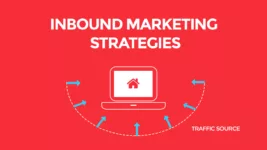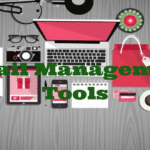Let’s start with a brief definition of what Inbound marketing is.
It is a marketing strategy that focuses on attracting customers to the business through useful content creation, rather than reaching out to customers in a disruptive manner for their attention.
Now how is it different than traditional outbound marketing? And why should we care about it? It is different in that it takes a totally different approach to marketing. You are no longer, running after the potential customer. You are making the customer come to you. You convert the visitor into a lead. And possibly into a long-term customer.
You should care because Inbound marketing is very cost effective compared to traditional methods of outbound marketing. It is one of the best forms of marketing for startups and small businesses. It has the potential to generate a lot of business in the long run. And it is only poised to grow in the coming years.
How does Inbound Marketing typically work?
It leverages the power of online search to generate leads.
It starts with creating useful content focused towards your niche market. You focus on the needs and pain points of your potential customer. You can then write an article addressing those pain points and giving them solutions.
When they search online for solutions, hopefully, they will find your site. Once they are on your site, you get an opportunity to capture their contact details. For a marketer that is one of the most valuable information to have.
It is very crucial to capture that information at that point. Because once they are gone, they are likely to never return again. Once they subscribe to your newsletter or social feeds, they will be constantly reminded of your presence when you send them a newsletter or an update.
It is very likely that whenever a need arises, they will turn to you for solutions.
So instead of pestering the customer to buy, you attracted them through content. Grew their confidence in you by providing useful information that answered their queries and pain points related to their niche. And whenever they needed a solution they turned to you to service them. That’s the beauty of inbound marketing.
So far, we have learned what Inbound marketing is and how it works. But how do you ensure your customers find you when they are looking for answers?
Because if they never find you, they never land on your site, right?
Let us now look at some Inbound Strategies we can use to make ourselves visible, and attract our potential customers to our site.
1. Creating Quality Content On Your Site.
The single most important aspect of inbound marketing is creating useful content on your site. A blog is typically the best place to create helpful and informational articles. A website is typically divided into pages and posts.
Pages are usually for information regarding the product & services being offered by the business. These are more like advertisements. These would also include the about, contact, terms pages etc.
Posts are articles & tutorials that usually are a part of your blog. You use these articles to address issues, concerns, pain points of your potential customers in your niche. These are written with the intention to help others. So, this is where your articles would go.
But should you just create any content?
It is not just enough to write articles on a regular basis. It is not likely to be effective if it does not resonate with your users.
One of the best ways is to do some research and see the issues your potential customers are facing. The information that they are seeking. To understand their pain points.
Suppose you are offering a solution targeted at roofing contractors. You should ideally think of a place where your potential customers hang out. LinkedIn is perhaps a good place to start your search from.
1. Go to LinkedIn and type in your keyword in the Search box next to the logo.

You would want to type in your keyword. Here we are searching for roofing.
2. Hit enter and you are presented with a screen displaying the Top results.

The top results page displays results from People, Jobs, Posts, Companies, Groups etc. We are particularly interested in Groups here. So we will click on the “Groups” tab.
3. This is how the “Groups” results page looks like:

It returned 405 results when I clicked on the Groups tab.
I would be interested in the groups with the most members. Because, probably, that is where we will find the most active members, actively discussing their issues and pain points.
We would like to visit each group and see the type of discussions taking place. If necessary, join the groups. Listen to the concerns and pain points that they are raising and discussing. Make a list of all the issues that pertain to your niche.
Similarly, you will find other groups on Facebook and Google+, and elsewhere too.
Once you have a master list, you will be able to see patterns. Issues that this segment is more concerned with.
Make a note of the ones that your product or service addresses. Then you can prepare in-depth articles addressing those concerns and pain points.
This part of my topic addressed creating quality content on your own site. When you create quality content which your users find valuable, it generally attracts linking.
So, creating content on your own site attracts links.
The next strategy is creating quality content and offer it to other high quality, authority blogs.
Guest Blogging on Authority Sites.
Once you are consistent with creating quality content on your own site, you should then consider offering the same quality content on other authority sites.
This is called Guest Blogging. Where you offer your quality content to be published on other sites.
How do you choose the sites, where you can guest blog? These would ideally be the sites that are similar to yours. These are sites with good authority. Sites that publish quality content themselves and attract visitors that could become your potential customers.
It is a mutually beneficial association, where you offer your expertise in the form of writing. And in return, you get more exposure and recognition, in front of a new audience.
Another major benefit is that you get direct links from that site when you offer them your guest blog. And links from well-established sites can be a game changer for any website.
So, guest blogging helps acquire direct links.
3. Take Care of On-Page SEO Factors.
When you are creating Inbound strategies, you need to look at various different factors.
Content creation and guest blogging are important aspects. This leads to an increased number of visitors to your own site. But if your site itself is not optimized well, it could lead to a higher bounce rate, a lower conversion rate and decreased visibility in search.
Inbound marketing and SEO are synonymous. So, you got to take care of your On-Page SEO to ensure increased visibility in search results, and ensure higher conversions.
You need to understand the anatomy of a perfect web page. I know nothing is perfect, and everything can be improved upon. Therefore, we should strive to get as near to perfection as we can.
On-page SEO is a huge topic in itself. It is not possible to go into as much detail as this topic demands. However, we will briefly touch upon some of the points that can help optimize your landing pages better.
Take care of the following on your landing pages:
- Add Images/Videos: Relevant images not only brighten up the page, but it also captivates the user’s attention. Videos are even better at conversions. What better than being able to sit back and watch and listen at the same time. So, consider adding different types of media on your pages. It can increase conversions by as much as 94%.
- Create Awesome Headlines: Don’t create boring headlines to feed the bots. Those days are gone. Instead, focus on user experience. Make the headlines stand out, and make them enticing. Ever seen the type of headlines on a Newspaper? Follow that style. But don’t overdo it to the point where users are disappointed when the article does not meet the hype your headline created. That would amount to a bad user experience.
- Target Long Tail Keywords: Try as much as you can, but you are not going to rank number one for keywords like Shoes, iPhone, Laptop, Computer etc. It is wise to look at long tail key phrases that narrow your audience considerably.
- Optimize Website for Speed: Faster speeds directly correlate with higher rankings. Check & Optimize your site speed here: https://developers.google.com/speed/pagespeed/insights/
- Ensure Site is Mobile Friendly: Your visitors are not only on desktops but using all sorts of mobile devices. Ensure you provide a good user experience by making your site easily accessible on all devices.
These are some of the points you should keep in mind while optimizing your web page. A well-optimized site is likely to feature higher on the search results page. And with a good backlink profile, it should bring in loads of traffic and sales.
4. Syndicating Content on Social Media
It is important to form a strategy to syndicate your content on social media. Because having good content on your site is not good enough to attract linking. Building links needs proactive efforts on your part. You will have to make use of social media to extend your reach and grow a dedicated audience for your site.
Create your business page on as many social media platforms as you can. If you find it hard to cope up maintaining too many of them, you can start off with the most important ones first.
I am listing a few of them below:
- Google+
- YouTube
Add to this list any other platform that you feel is important for your business to have a presence on.
The articles you create on your website should be shared on these platforms. When you don’t have a decent enough following, it wouldn’t look like much. But something is better than nothing. But when over time, you grow a big enough audience, these would produce bigger results.
But do remember, that followers don’t grow overnight. You must give it time and you need to be patient. There is no substitute for hard work & patience.
But social media must form an important part of your Inbound marketing strategy. Social media is not the perfect platform for higher conversions. But it is a very good platform to build your brand.
5. Developing A Strong Personal Brand
The next strategy focuses on developing a strong personal brand of your own. You as the owner, promoter, founder, are inseparable from the business you started.
So, it only makes sense that you develop yourself as a brand and use your brand value to propel your business to even greater heights.
But building a strong brand requires planning and consistent effort. It has the potential to provide the right platform, where you can see opportunities, and let opportunity see you. You are not among the crowd where life is so harsh and mundane that it becomes too big an effort to rise high enough to let opportunity see you.
A strong brand separates you from the rest of the crowd. You are no longer just another face. People know you, they recognize you as an expert in your chosen field. They want your suggestion, opinion on things that matter to them.
There is a certain level of trust and faith that makes people willing to give you new opportunities easily.
So how do you build your own brand?
As I mentioned above it is a strategy that requires planning and consistent efforts.
A few things you can do to get started building your own brand.
- Start with a mission & vision: As with a company mission & vision, you need to have your own personal one too. Preferably write it down somewhere where can see it and read it every day. So that it is consistently on your mind. You are your thoughts. So, let mission, vision, & goals thoughts dominate your mind at all times.
- A strong online presence: Create social profiles on all social media platforms. Make the profile pics you choose depict who you are. They should be high resolution and should show you in a positive light. You want to separate yourself from the ordinary here. If possible, also acquire a domain name for you and get a website that speaks for you. The goal here to build a positive image of yourself. And also, to dominate online search when someone searches for you.
- Guest blogging: I discussed guest blogging above. Yes, brand building & recognition is a positive outcome of doing this the right way. Do this on a consistent basis. Not with the intent of solely acquiring links, but to build your brand value and to acquire a new audience.
- Outreach: Reach out to influencers and forge strong friendships wherever possible. People will do a lot more for friends than they would for a mere acquaintance. Networking online is not enough. If possible meet face to face and forge relationships that go beyond business.
These steps should get you started on the right path to creating a strong brand for yourself.
Conclusion
These inbound strategies are very doable and easy to follow. If done consistently and persistently, has the potential to create an income stream that compounds and grows with time.
No chasing around your potential customers for work. When these steps are combined it works synergistically to build links, online visibility, and brand building. You are basically providing value and free information to your visitors. You are not forcing them to buy anything.
Inbound marketing is all about making your presence felt. Letting your potential customers know you are there. And that they can come to you when the need arises.
That is the beauty of Inbound marketing and the reason why it has gained so much in popularity over the past years.
Let me conclude the article here. But I am keen to hear your thoughts in the comments below.
Author Bio:
Amrit Ray takes care of marketing at Raydez & Ray Creations, a web design company working with global clients. He is also a singer/songwriter. He tries his best balancing both his passions giving adequate time to both. Follow him on Google + | LinkedIn | Twitter.








